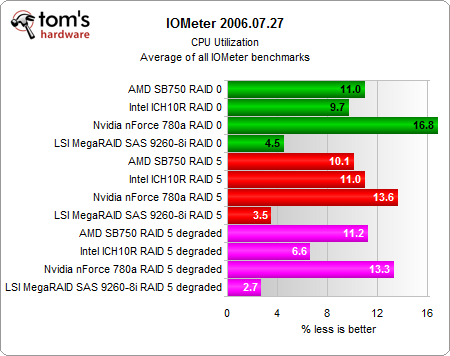Southbridge Battle: 780a, ICH10 and SB750, Compared
CPU Utilization And Conclusion
If motherboard-down storage is so great, then how are vendors like LSI able to eke out a business selling add-in cards, such as the 6 Gb/s SAS controller used here? A combination of onboard processing and plenty of memory help offload the intensive parity calculations, which otherwise have to be handled by a host processor. In the chart above, you can clearly see the impact on CPU utilization, LSI's controller doing a great job of offloading storage-based calculations and Nvidia's 780a SLI taking the most significant hit.
Conclusion
The only conclusion that can be easily drawn is that you need to have a professional storage controller such as the LSI MegaRAID SAS 9260-8i, which we used for performance comparison, if you want to get the most from your complex storage arrays. The SAS/SATA controller was the only one to deliver high (or at least balanced) performance in all benchmark disciplines with some exceptions for Intel's ICH10R. The LSI still was the only controller able to deliver up to 1 GB/s throughput using the six Intel X25-E SSDs we had for testing, deliver high performance at writes and even when an array is degraded, and support a battery backup unit and professional RAID management features. Hence this card or similar professional products can be the only choice for truly mission-critical applications. The fact that the integrated storage controllers typically beat it in the I/O performance benchmarks may be due to the SSDs, which we found can be CPU-bound (see article Does Power-Saving Technology Kill SSD Performance?).
I/O Performance
All integrated solutions deliver amazingly high I/O performance, but results differ depending on the I/O benchmark pattern, which varies in access type and block sizes. Intel is superior in most of our I/O tests. Running high I/O loads on a degraded RAID 5 array results in a performance drop of around 30% to 60%, which seems acceptable.
Throughput
If you need a RAID array to deliver maximum read throughput, then you might want to go for a fast system using the ICH10R, since Intel’s controller delivers more than 650 MB/s in RAID 5 and 600+ MB/s in RAID 0. LSI stays tightly in the 460 to 480 MB/s range, while AMD and Nvidia limp along, struggling to catch even 200 MB/s.
Get Tom's Hardware's best news and in-depth reviews, straight to your inbox.
Keep in mind that this is valid only for reads. If you switch to writes, AMD and Nvidia look even worse, yielding performance numbers not worth mentioning. Intel’s ICH10R still does well in write throughput and can be considered a competitor to LSI’s professional card—until you look at performance in degraded RAID 5. The only solution capable of maintaining at least 390 MB/s and still reaching 680 MB/s is LSI’s MegaRAID 9260-8i with its RAID-on-chip architecture.
Integrated RAID Good for Temporary High Performance Storage
The southbridges we looked at were designed to power desktop PCs, a purpose in line with our results. These chips aren’t built to be server/workstation solutions, so we don’t recommend creating complex RAID arrays on desktop systems. RAID 0 and RAID 5 performance work well for reads, but results are less than acceptable for writes with the exception of Intel’s ICH10. The AMD and Nvidia RAID offerings only are satisfactory, provided you don’t need high write performance…at all. We recommend using integrated RAID 0 or 1 options for temporary high performance storage, but RAID 5 should be left to professional products.
Current page: CPU Utilization And Conclusion
Prev Page Benchmark Results: Read/Write Throughput